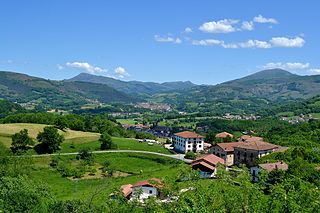The Basques are a Southwestern European ethnic group, characterised by the Basque language, a common culture and shared genetic ancestry to the ancient Vascones and Aquitanians. Basques are indigenous to, and primarily inhabit, an area traditionally known as the Basque Country —a region that is located around the western end of the Pyrenees on the coast of the Bay of Biscay and straddles parts of north-central Spain and south-western France.

Henry IV, also known by the epithets Good King Henry or Henry the Great, was King of Navarre from 1572 and King of France from 1589 to 1610. He was the first monarch of France from the House of Bourbon, a cadet branch of the Capetian dynasty. He pragmatically balanced the interests of the Catholic and Protestant parties in France as well as among the European states. He was assassinated in 1610 by a Catholic zealot, and was succeeded by his son Louis XIII.

Navarre, officially the Chartered Community of Navarre, is a landlocked foral autonomous community and province in northern Spain, bordering the Basque Autonomous Community, La Rioja, and Aragon in Spain and Nouvelle-Aquitaine in France. The capital city is Pamplona. The present-day province makes up the majority of the territory of the medieval Kingdom of Navarre, a long-standing Pyrenean kingdom that occupied lands on both sides of the western Pyrenees, with its northernmost part, Lower Navarre, located in the southwest corner of France.

Pamplona is the capital city of the Chartered Community of Navarre, in Spain.

Henry II, nicknamed Sangüesino because he was born at Sangüesa, was the King of Navarre from 1517, although his kingdom had been reduced to a small territory north of the Pyrenees by the Spanish conquest of 1512. Henry succeeded his mother, Queen Catherine, upon her death. His father was her husband and co-ruler, King John III, who died in 1516.

John II, called the Great or the Faithless, was King of Aragon from 1458 until his death in 1479. As the husband of Queen Blanche I of Navarre, he was King of Navarre from 1425 to 1479. John was also King of Sicily from 1458 to 1468.

Basque nationalism is a form of nationalism that asserts that Basques, an ethnic group indigenous to the western Pyrenees, are a nation and promotes the political unity of the Basques, today scattered between Spain and France. Since its inception in the late 19th century, Basque nationalism has included Basque independence movements.

The Kingdom of Aragon was a medieval and early modern kingdom on the Iberian Peninsula, corresponding to the modern-day autonomous community of Aragon, in Spain. It should not be confused with the larger Crown of Aragon, which also included other territories—the Principality of Catalonia, the Kingdom of Valencia, the Kingdom of Majorca, and other possessions that are now part of France, Italy, and Greece—that were also under the rule of the King of Aragon, but were administered separately from the Kingdom of Aragon.

The Basque Country is the name given to the home of the Basque people. The Basque Country is located in the western Pyrenees, straddling the border between France and Spain on the coast of the Bay of Biscay.

Lower Navarre is a traditional region of the present-day French département of Pyrénées-Atlantiques. It corresponds to the northernmost merindad of the Kingdom of Navarre during the Middle Ages. After the Spanish conquest of Iberian Navarre (1512–24), this merindad was restored to the rule of the native king, Henry II. Its capitals were Saint-Jean-Pied-de-Port and Saint-Palais. In the extreme north there was the little sovereign Principality of Bidache, with an area of 1,284 km2 (496 sq mi) and a decreasing population of 44,450, 25,356.

The Kingdom of Navarre, originally the Kingdom of Pamplona, was a Basque kingdom that occupied lands on both sides of the western Pyrenees, with its northernmost areas originally reaching the Atlantic Ocean, between present-day Spain and France.

The Navarrese People's Union, abbreviated to UPN, is a regional conservative political party in Navarre, Spain. Until 2008, it was a fraternal party of the People's Party (PP), acting as the latter's Navarrese branch.

Roncesvalles is a small village and municipality in Navarre, northern Spain. It is situated on the small river Urrobi at an altitude of some 900 metres (3,000 ft) in the Pyrenees, about 4 kilometres (2.5 mi) from the French border as the crow flies, or 21 kilometres (13 mi) by road.

Saint-Jean-Pied-de-Port is a commune in the Pyrénées-Atlantiques department in south-western France. It is close to Ostabat in the Pyrenean foothills. The town is also the old capital of the traditional Basque province of Lower Navarre. Saint-Jean-Pied-de-Port is also a starting point for the French Way Camino Francés, the most popular option for travelling the Camino de Santiago.
Corella is a town and municipality in the province and autonomous community of Navarre, northern Spain. It is located 91.5 km from Pamplona, and is on the River Alhama, a tributary of the Ebro River. The population in 2023 was 8,629 inhabitants. Corella is the second most populated municipality in the Ribera of Navarre, southern part of Navarre. Corella is well known for its wine.

Baztan is a municipality from the Chartered Community of Navarre, northern Spain. It is located 58 km (36 mi) from Pamplona, the capital of Navarre. It is the largest municipality in Navarre, with around 376.8 km2 and just over 8,000 inhabitants.

The Navarre autonomous football team is the regional football team for Navarre, Spain. It is not affiliated with FIFA or UEFA because it is represented internationally by the Spain national team, and only plays in friendly matches.

The Southern Basque Country refers to the Basque territories within Spain as a unified whole.

The Gipuzkoa Regional Championship was an official football tournament in Spain, organised by the Gipuzkoan Football Federation in which affiliated clubs participated. It was played annually between 1918 and 1940 and served to elect the representative of the territory in the Copa del Rey.



















